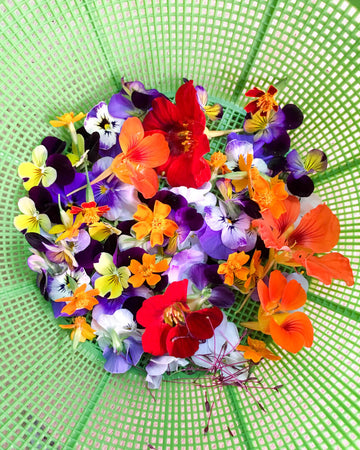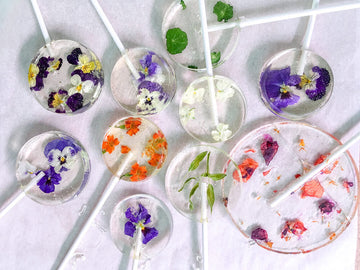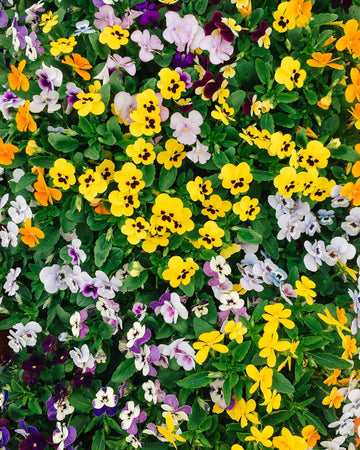May 16, 2020
Can You Freeze Edible Flowers? (And other questions) How to Properly Store and Take Care of Your Edible Flowers

Use edible flowers as soon as possible after purchase. Generally speaking, flowers with small or thin petals have a shorter shelf life.
Here is a general list featuring the main flowers we sell, but your personal experience may vary according to your storage conditions. If kept in optimal conditions, they can last up to a week.
Best used by 2 days: Viola, Borage, Torenia, Nasturtium, Cornflower, Sweet William, Basil
Best used by 3-4 days: Calendula, Marigold
How Long Do Edible Flowers Last?
- All fresh produce should be used as soon after harvest as possible, and edible flowers are no exception. They are perhaps one of the most fragile in terms of shelf life, and their "best by" date is around two days.
- However, most edible flowers will be usable for 4-6 days if kept in an airtight container in the fridge. You may start to see some wilting and curling around day 3, and you should use all flowers within seven days.
- The best way to have a continuous, long-lasting supply of edible flowers is to grow them yourself! On the plant, many blossoms will be available for harvest from a week to a month-long. Just snip the blossoms off with a sharp pair of scissors, clean, and use immediately. Often, cutting off not more than 30% of the blossoms will help encourage more blossoms to form. Read our post about growing your own edible viola flowers - one of the easiest-to-grow and most prolific varieties.
- TIP: You can sometimes revive wilted or droopy flowers by placing them in an ice water bath for 10 minutes or so. This can re-hydrate the flower’s cells and give it a breath of new life. Use them immediately after removing from the ice water bath.

Make your flowers last by preserving them in candy.
Read our guide on how to turn your edible flowers into beautiful crystallized decorations for cakes and other baked goods. Or, you can mold them into gorgeous edible flower lollipops, which make great party favors at birthday parties or bridal showers.
Can I preserve my edible flowers? Try these 3 techniques.
- If you want to use your edible flowers for baking, you can crystallize them and incorporate them into frostings. Or you can candy them in the form of edible flower lollipops. To learn how, check out our guide!
- Dry your edible flowers in a food dehydrator. Spread the flowers so they are not touching, and dry on low heat for a couple of hours, until the petals have no remaining moisture. Once dry, you can store them in airtight containers for several months. Sprinkle the dried petals onto cakes or other food that needs a touch of floral beauty.
- Another technique is freezing your edible flowers into ice cubes to brighten up any cocktail or any clear colored beverage. Fill an ice cube tray halfway with water, add a flower, and let it set for an hour in the freezer so that the flower stays in the center of the cube. Fill up the remaining top half of the tray with water and place back into the freezer until completely frozen.

Nasturtium in Large Ice Cube Trays

Viola and Borage in Ice Cube Trays

Assorted Edible Flowers Spread For...
Things to look out for when buying edible flowers.
Proceed with caution when eating edible flowers. Only buy your edible flowers from a source you can trust where you are sure you are getting a safe, edible species of flower. The seller should guarantee that the flowers were grown without the use of pesticides or fungicides. If foraging for wildflowers, be extremely confident when identifying species of flowers to avoid eating anything toxic or unfit for consumption. If in doubt, don't eat it.
- Mold. Especially important if you are buying your edible flowers packaged in a supermarket. Sometimes it's hard to know how long they've been stored and in transit from the farm. Look inside the package to make sure there is no mold spreading among the petals. It will usually be a web-like, greyish white mold that fuses the leaves and petals together.
- Color. Flowers should look freshly picked, vibrant, and bright. If the colors have started to fade, or they look dull and lifeless, they may be expiring.
- Petals. The petals should be perky and life-like. A loss of rigidity is normal after harvest, but they should not become too limp and floppy. Any browning or decaying bits around the edges is a bad sign.
Some of our favorite edible flowers that we grow at Common Farms.

Calendula

Purple Basil

Marigold
Frequently Asked Questions
Edible flowers are delicate and require special care. Here are some frequently asked questions about how to properly handle and store edible flowers.
- How do I know if my flowers are safe to eat?
- What kind of container is best for storage?
- How do I use edible flowers in a salad?
- Can you freeze edible flowers?
- Do I need to clean or rinse edible flowers before consumption?
- Should I remove the stamens and pistils that contain pollen?
Violas are some of the easiest, quickest to grow edible flowers, and some of the highest producing.
There are so many ways you can use violas. Use them fresh as a decoration for cakes. Turn them into candy. Freeze them. Bake them into cookies. Press them into fresh pasta. Float them on top of cocktails. Brighten up a salad. And more! Click the link below to learn all about growing your own edible viola flowers.

What About Home-grown Flowers?
- If you grow your own edible flowers, then harvest them from the garden right before you're ready to use them. Line an airtight, plastic or glass container with a damp paper towel, and place the harvested flowers gently on top. This will keep the flowers moist and prevent them from wilting. Close the lid and place it in the fridge, or use immediately.
- Choose flowers that have just fully opened when they are at their peak appearance and freshness. Blossoms that have not fully opened or blossoms with petals that have started to wilt should not be used.
- To clean edible flowers harvested from your garden, use a soft clean brush, such as a watercolor paintbrush, to gently dust off any debris or small insects. Avoid rinsing under running water as you may end up damaging the petals. Instead, lightly dip them into a bowl of cool water and slowly swish them back and forth a couple of times to dislodge any particles of dust or dirt. Do not use a salad spinner as the rapid motion could damage delicate petals. Be especially careful when handling flowers with dark-colored or thin petals, as damage to these petals will be more noticeable than on flowers with light-colored or thick petals.
- A note on insects: generally speaking, tiny black or green insects you may find on your flowers, such as aphids, can be gently brushed off and should have no impact on the edibility of your flower. Stubborn insects can be dislodged by gently dipping the flower in water. In fact, insects are a good sign that your flower is free from pesticides, which are much more harmful to our bodies than most insects if ingested. However, if in doubt, do not consume anything you view as unsafe.
- It is best to harvest flowers in the early hours after the morning dew has dried. This is when the flowers have the most water content before being exposed to the sun and the heat. If you harvest too early, when they are wet, they may stick together in storage. Harvest too late in the day, and their shelf life will be reduced.
- Store them in a box, not a bag, so they are less likely to get crushed.


